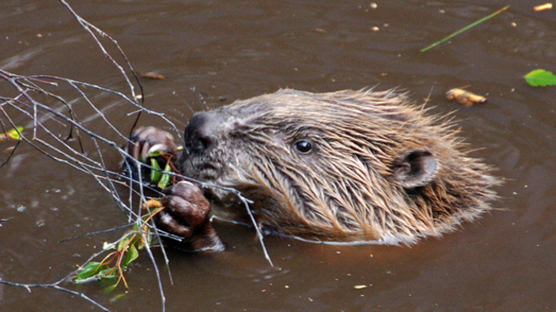
Beavers
Busy, busy workers
Teeth axes to trees
Cutting, molding, building
Nature’s engineers
Busy, busy workers
Teeth axes to trees
Cutting, molding, building
Nature’s engineers

An integral part of the Northwest ecosystem in its wooded wetlands is the beaver. Beavers are the second largest rodent with the most frequently pictured giant-sized teeth. They are related to squirrels. However, they have webbed hind feet with a second hind-toe that is doubled. In times of danger or stress, they will slap a flattened tail. This signals other beavers to dive or hide. Their size ranges upward of two feet in length. They have two coats of fur. An inner layer, silky and grey, is much sought after by hunters and has nearly brought about their demise in many parts of the world. The outer fur is more reddish brown and coarse. Their eyesight is extremely poor which is compensated for with keen hearing, smell and touch. Quite social, they colonize in areas around creeks or small parts of rivers.
Beavers instinctively build dams with the sound of running water. The dams provide protection and a food source. To some, it may seem that the destructive force of the beaver teeth in cutting down trees is actually detrimental to the health of the forest. They can destroy mature trees and their dams or the downed trees can cause flooding. Economically, this destruction can be huge when dealing with undermining of railways and roadways. However, the beaver’s work in building dams is often essential to numerous forms of wildlife that exist in the wetland areas. They reduce the rush of many streams which allow some forms of aquatic life to thrive. This may also reduce erosion. Their dams support biodiversity by providing habitat for life forms that are currently endangered.
Beaver do better work than the Corps of Engineers.
Mike Todd
All life demands struggle. Those who have everything given to them become lazy, selfish, and insensitive to the real values of life. The very striving and hard work that we so constantly try to avoid is the major building block in the person we are today.
Pope Paul VI
Beavers instinctively build dams with the sound of running water. The dams provide protection and a food source. To some, it may seem that the destructive force of the beaver teeth in cutting down trees is actually detrimental to the health of the forest. They can destroy mature trees and their dams or the downed trees can cause flooding. Economically, this destruction can be huge when dealing with undermining of railways and roadways. However, the beaver’s work in building dams is often essential to numerous forms of wildlife that exist in the wetland areas. They reduce the rush of many streams which allow some forms of aquatic life to thrive. This may also reduce erosion. Their dams support biodiversity by providing habitat for life forms that are currently endangered.
Beaver do better work than the Corps of Engineers.
Mike Todd
All life demands struggle. Those who have everything given to them become lazy, selfish, and insensitive to the real values of life. The very striving and hard work that we so constantly try to avoid is the major building block in the person we are today.
Pope Paul VI
